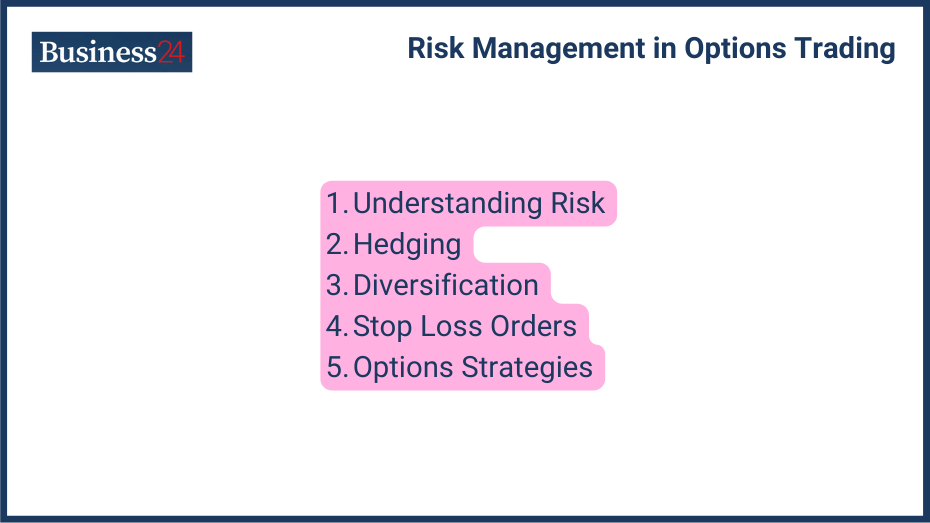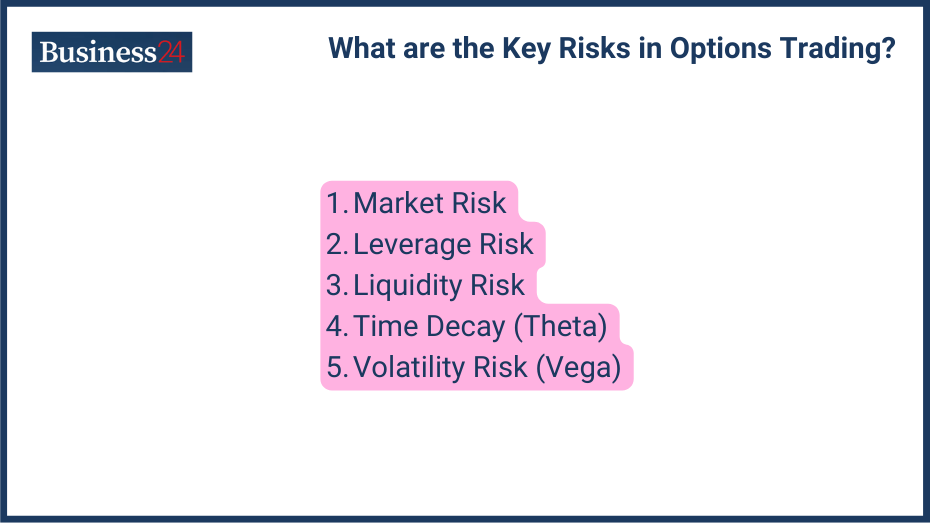
The factor that differentiates a profitable trader from a struggling trader is how they manage their risk. This is the thing that most trader ignores in their trading career; however, risk management is the first and most important factor to learn while trading, whether it is options or any other asset or instrument. Options are highly volatile and risky trading instruments, and if not managed appropriately, risk can result in big losses.
As the famous new-age trader Steve Burns stated, “The best education for a new trader is risk management and the right psychology, but most new traders want to focus on the best entries for making fast money.” Risk management is the first thing you should learn when entering trading.
What is Options Trading Risk Management?
Options trading risk management is the strategies and techniques employed to minimize potential losses while maximizing potential gains in options trades. Without risk management, it wouldn’t take much time to blow your capital. It’s the foundation of successful options trading, which will help you in protecting capital and make better decisions.
Basic Principles of Risk Management:
- Know what you are doing: Before trading options, you should know everything about it. You have to understand options contracts, pricing, and associated risks before taking trades.
- Diversification: You shouldn’t put all your money in a single instrument or strategy as a beginner, you have to spread your investments across various options, strategies and underlying assets to manage your risk.
- Capital Allocation: This is a very important topic. Allocating the right amount of your capital for options trading and specific strategies or assets will help you manage your money better.
- Position Sizing: You cannot trade randomly if you want to make money. You have to carefully calculate the size of each trade relative to your account balance and risk tolerance.
What are the Key Risks in Options Trading?

Market Risk
It’s the market’s action that influences the underlying asset’s price behavior and that impacts the options price. The value of options is derived from the underlying asset’s price, meaning that any unexpected movements in the market can lead to substantial changes in the option’s premium.
These fluctuations can result in significant gains or losses for investors, as an option’s potential profit or loss is directly influenced by the underlying asset’s price movements. Understanding these price behaviours is important for options traders in managing risk.
Leverage Risk
Leverage in options trading allows investors to control a larger position with a smaller upfront investment, but keep in mind that both profit and losses can be big and even a small market movement can lead to substantial profits or significant losses. Leverage magnifies the financial impact of price changes in the underlying asset, making options a powerful but high-risk investment tool.
Liquidity Risk
There is a risk that you can face difficulty in entering or exiting an options position quickly at a fair price, often arising with less frequently traded options contracts. This risk can impact trading and pricing by causing wider bid-ask spreads and making it challenging to execute trades at desired prices, thereby increasing transaction costs and potential slippage.
Time Decay (Theta)
One of the most important Greeks in trading options. It is the nature of options that lose value over time, regardless of the underlying asset’s price movement, which is known as theta decay. Theta increases as the expiry date approaches, decreasing the option’s value. This time decay impacts options more intensely as they near expiration, making them increasingly susceptible to value loss.
Volatility Risk (Vega)
Volatility plays an important role in options pricing as it measures the price fluctuations of the underlying asset. Higher volatility generally increases the prices of options because the likelihood of the option ending in the money is higher, thus increasing its potential payoff.
Conversely, lower volatility results in lower option prices. Strategies to manage volatility risk include selling options (options writing), which can be profitable in high-volatility environments since the premium received is higher. However, the increased cost makes buying options riskier in volatile markets. Utilizing spreads, such as vertical spreads, can help hedge against volatility fluctuations by offsetting the risk of one option with another.
What role do options play in risk management?
Options can be used to manage risk in a portfolio. By using specific strategies like:
- Protective Puts: if you have holdings in your portfolio and want it to safeguard it from the downside, you buy puts, so if the asset starts going down, puts will gain value offsiding your loss in the holding. Buying put options limits potential losses on a stock holding.
- Covered Calls: This is similar to the above, but instead of buying puts, you sell calls here. Selling call options against stock you own generates income while capping potential gains.
What are the Fundamental Strategies for Managing Options Trading Risks?
Diversification
As I said earlier, you cannot put your whole capital in one trader, and it will highly increase the risk. You should diversify your options trades across different expiries, underlying assets, and strategies to reduce exposure to any market movement.
Consider a mix of call and put options, different expiry dates, and options on various asset classes (stocks, indices, commodities).
Position Sizing
Position sizing will help you control risk in a planned manner. Allocate a specific percentage of your trading capital to each trade, typically 1-5%, depending on your risk tolerance and strategy.
You can use the “One-Percent Rule,” which limits each trade to 1% of your account value. The “Kelly Criterion” (a more complex formula) determines win rates and risk-reward ratios.
Setting Stop-Loss Orders
Stop loss is the trader’s edge, stop-loss orders automatically exit your position when the underlying asset reaches a predetermined price, limiting potential losses.
You can set stop-loss orders based on technical analysis or a fixed percentage below your entry price. There are various methods of placing stop-loss orders; you can also use trailing stop-loss orders that adjust as the price moves favorably.
Taking Profits Early
As entry and stop loss are important, taking a profit at the right time is also necessary. You can hold off on thinking of maximum potential gains if conditions are not favorable. Taking profits early when the market moves in your favor secures your returns.
Aim for a healthy balance between risk and reward; even 1:2 is enough to make you profitable but try taking a higher RR. Consider taking profits when you reach a target percentage gain.
How do you manage risk-reward in options trading?
Effective options trading is a balance between potential gains and potential losses. Here are some methods you can use to manage risk-reward in options trading:
1. Define Your Risk-Reward Ratio
It’s very important to know what you are going to gain for the risk you are taking. Before taking any trade, look for a risk-reward ratio that aligns with your risk tolerance. A common benchmark is 1:2, meaning you target a potential profit that is twice the amount you’re willing to risk, but i would suggest look for a higher risk reward ratio.
Adjust this ratio based on your strategy and market conditions. Higher risk strategies like naked calls may require a higher risk-reward ratio (e.g., 1:3).
2. Prioritize Position Sizing:
Apply position sizing principles to ensure your potential losses are controlled. The “One-Percent Rule” limits each trade to 1% of your account value. Consider the option’s price (premium) and potential profit when calculating position size. Allocate more capital for trades with a higher potential return relative to risk.
3. Identify Entry and Exit Points:
Be efficient in your entry and exit points for your trades based on technical analysis or price targets. Entry points should align with your strategy (buying calls for a bullish outlook, also set stop-loss orders to automatically exit positions when the price moves against you, limiting potential losses. Consider trailing stop-loss orders that adjust as the price moves favorably.
What are the Advanced Risk Management Techniques in Options Trading?
Hedging Strategies
Hedging means using options to protect existing holdings or limit portfolio risk if it goes in the opposite direction of your position. You can use:
- Protective Puts: Buying put options alongside a stock holding allows you to profit if the stock price falls, effectively hedging your downside.
- Covered Calls: Selling call options against your own stock generates income while capping potential gains. This strategy is useful in a sideways or slightly bullish market.
Spread Strategies
This is one of the most used option strategies; in spread strategy, you buy and sell options contracts with different strike prices or expiration dates on the same underlying asset. Here are some of the examples:
- Bull Spreads: In this strategy, you have to buy a call option and sell a higher strike call option with the same expiry. This strategy offers lower potential profits but limits risk compared to buying a single-call option.
- Bear Spreads: Similar to bull spreads but with put options, you have to sell a put option and buy a lower strike put option with the same expiry. These will profit if the underlying asset price falls but limit potential gains compared to buying a single put option.
- Calendar Spreads: Calendar Spreads buy a longer-dated call option and sell a shorter one at the same strike price. Calendar spreads benefit from a gradual increase in the underlying asset price.
Using Options Greeks
The Greeks (Delta, Gamma, Vega, Theta, and Rho) measure the sensitivity of an option’s price to various factors like underlying asset price changes (Delta) or volatility (Vega) and help a trader understand the option’s different characteristic.
You can assess the potential impact of market movements on your options positions and make informed risk management decisions by understanding the options greeks. For example, Delta indicates how much the option’s price will change relative to the underlying asset’s price movement. This helps you calculate potential profit/loss and set stop-loss orders.
What Tools and Resources Help Manage Options Trading Risks?
Risk Management Software
Software like VectorVest offers tools to analyze options contracts, assess risk-reward ratios, and backtest strategies before you put your money. These tools can help you analyze potential outcomes and make data-driven risk management decisions.
Educational Resources
There are various good books and articles published on risk management, and you can learn a lot from them. Also, there are some good courses you can look for that can help you learn systematic risk management.
Financial Calculators and Simulators
Options calculators will help you determine the price, risk, and potential reward of various options strategies. With an option calculator, you can also use trading simulators, which will allow you to practice options trading in a risk-free environment, test your strategies, and refine your risk management approach.
What are Practical Examples and Case Studies in Options Trading Risk Management?
Real-World Examples
You can learn from others’ mistakes; you have to analyze real-world examples of successful risk management techniques experienced options traders use. This can provide valuable insights into practical applications. There are various case studies published that show how options used to hedge portfolios or limit losses can be instrumental learning tools.
Learning from Mistakes
The best way to learn in trading is to learn from your mistakes. Identify common pitfalls that lead to options trading losses, such as bad risk management or ignoring the Greeks. Make a journal, start logging your trades, and review them. You can use case studies to improve mistakes and maintain a good risk management strategy.
What is the Importance of Ongoing Education and Adaptation in Options Trading?
Options trading is a big profession that requires a lot of hard work. Also, constantly evolving alongside market trends and new strategies can sometimes make it more difficult. Proper education and adaptation in option trading are very important.
Staying Informed
Options are risky financial instruments. Dedicating yourself to continuous learning is crucial. Stay updated on market dynamics, new options strategies, and regulatory changes that might impact your trading. You have to explore new books, articles, and online courses from reputable sources. Consider attending webinars or workshops led by options trading experts.
Adapting Strategies
Regularly assess your current options trading strategies. Analyze past performance, identify areas for improvement, and don’t be afraid to revise your approach based on what you have learned. Don’t be rigid in your strategy; the options market demands adaptability. Be prepared to adjust your risk management techniques, position sizing, and even exit points based on market conditions and your evolving risk tolerance.
The market itself offers valuable feedback. Analyze your wins and losses, and identify what worked and what didn’t. Use these insights to refine your understanding of risk management and adapt your strategies accordingly.
Disclaimer
eToro is a multi-asset platform which offers both investing in stocks and cryptoassets, as well as trading CFDs.
Please note that CFDs are complex instruments and come with a high risk of losing money rapidly due to leverage. 51% of retail investor accounts lose money when trading CFDs with this provider. You should consider whether you understand how CFDs work, and whether you can afford to take the high risk of losing your money
This communication is intended for information and educational purposes only and should not be considered investment advice or investment recommendation. Past performance is not an indication of future results.
Copy Trading does not amount to investment advice. The value of your investments may go up or down. Your capital is at risk.
Don’t invest unless you’re prepared to lose all the money you invest. This is a high-risk investment and you should not expect to be protected if something goes wrong. Take 2 mins to learn more
eToro USA LLC does not offer CFDs and makes no representation and assumes no liability as to the accuracy or completeness of the content of this publication, which has been prepared by our partner utilizing publicly available non-entity specific information about eToro.
